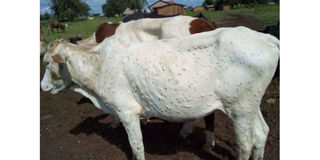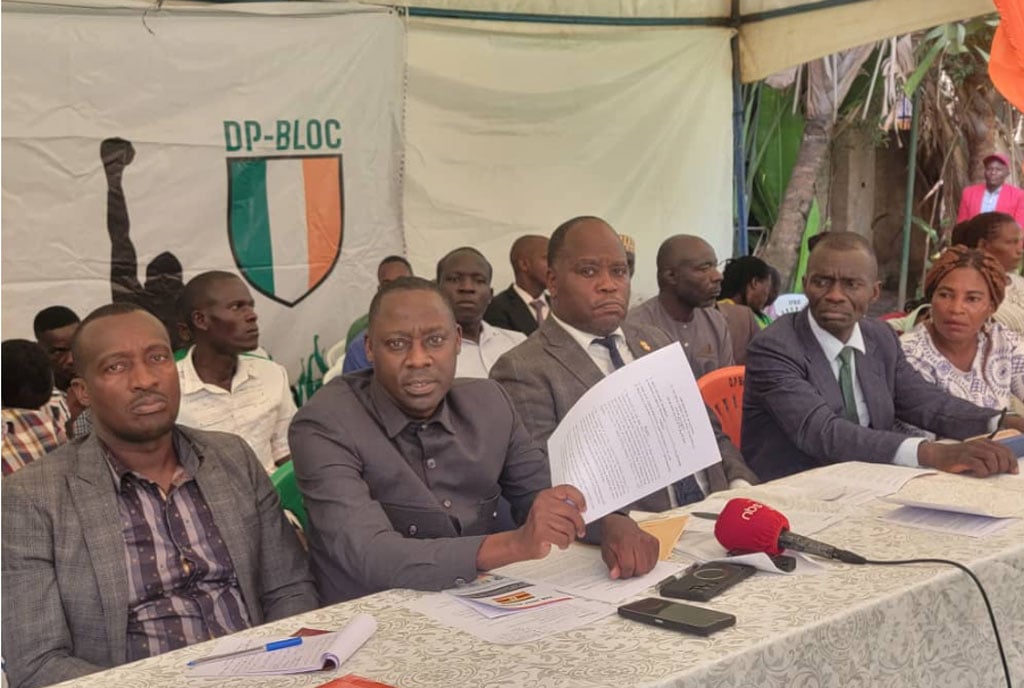Cattle skin disease hits Namisindwa

Some of the cows infected by lumpy skin disease. The disease, which causes miscarriages and also reduces milk production in cows, has spread to several sub-counties in Namisindwa District. PHOTO | FILE
Farmers in Namisindwa District are crying foul following the outbreak of lumpy skin disease, which has so far left hundreds of heads of cattle infected.
Lumpy skin is a viral disease caused by pox virus that affects cattle and it is transmitted by blood-feeding insects such as mosquitoes and ticks, and birds.
Animals affected with cattle lumpy disease have signs and symptoms such as fever and nodules on the skin. It can also lead to death, especially in animals that have not previously been exposed to the virus.
Mr David Mityelo, the district acting production officer, on Monday said several sub-counties in the district are affected.
Among the affected sub-counties are Bumbo, Bukokho, Buwatuwa, Lwakhakha, Tsekululu, Mukoto and Bukhabusi.
Mr Mityelo said since the start of this month, his office has received more than 100 cases of animals which died but many are not reported by farmers.
“Lumpy skin disease neither has a cure nor treatment since it is a virus but it can be prevented from spreading by enforcing quarantine, isolation of sick animals and vaccination, which the district has started implementing in the affected areas,” Mr Mityelo said.
Mr Jackson Wakwaika, the district chairperson, said this disease has spread from Kenya side since Namisindwa is a bordering district.
“Traders who cross-trade animals with their counterparts from Kenya are the ones who imported this disease because western Kenya is currently having the outbreak of lumpy disease,’’ Mr Wakwaika said.
He added that the district has already alerted the Ministry of Agriculture, Animal Industry and Fisheries but up to now, they are yet to receive a response.
“We have not yet received the response in terms of vaccinations and they have not sent a team on the ground to assess the situation,” he said.
Mr Wakwaika said as a district, they have started massive sensitisation of farmers using sub-county extension workers to equip them with knowledge on how to curb the spread.
Ms Julie Namara, the deputy Resident District Commissioner, said they have already banned the cross-border trade of animals as a way of stopping the further spread.
She also said the district has received some few dozes of vaccines from development patterns which they are using to vaccinate in most hit sub-counties.
“I appeal to farmers to embrace the ongoing vaccination exercise. Cattle traders should obey the ban on external and internal trade of animals too,” Ms Namara said, adding that district security committee and production department announced a ban on movement of cattle in order to curb down the spread of the disease.
Mr Samuel Kundu, the chairperson of Buwatuwa, one of the most hit sub-counties, said most of the cattle traders are not respecting the ban on cattle movement.
“The traders in my sub-county and other neighbouring areas are big headed because they are still smuggling meat and trading animals to other neighbouring districts such as Bududa and Manafwa,” he said.
He also said the spread would have not been at this rate had the traders abided by the security rules which were issued.
“As a solution, the local councils from different sub-counties should help the district by impounding meat and live animals which they are trading in their areas,” Mr Kundu said.
Mr Samuel Nandokho, one of the affected farmers from Lwakhakha Town Council appealed the Agriculture ministry to procure free vaccines.
“Some farmers can’t afford Shs2,000 per cow for vaccination because most of the farmers are ordinary people with no known source of income,” Mr Nandokho, said.
However, Mr John Musila, the Member of Parliament for Bubulo East in Namisindwa District, described the outbreak as the worst disaster farmers have encountered in the district since it was created.
“Most of the farmers have been expecting to sell their animals to get fees, which is not going to be as expected due to the ban announced by the district on animal trade,” Mr Musila, said.
He added that they are still engaging the line ministry to have a quick response on this outbreak to save farmers from losses.
We were unable to get a comment from the Ministry of Agriculture, Animal Industry and Fisheries by press time.
About lumpy skin
Lumpy skin disease is an infectious, eruptive, occasionally fatal disease of cattle characterised by nodules on the skin and other parts of the body.
Secondary bacterial infection often aggravates the condition.
Traditionally, lumpy skin disease is found in southern and eastern Africa, but in the 1970s, it extended northwest through the continent into sub-Saharan West Africa. Since 2000, it has spread to several countries of the Middle East and in 2013 extended west into Turkey and several countries in the Balkans. More recently, outbreaks of lumpy skin disease were reported for the first time in Georgia, Russia, Bangladesh, and the People’s Republic of China.
The recent geographic spread of lumpy skin disease has caused international concern.
Quarantine restrictions have proved to be of limited use. Vaccination with attenuated virus offers the most promising method of control.
Source: MSD Veterinary Manual




